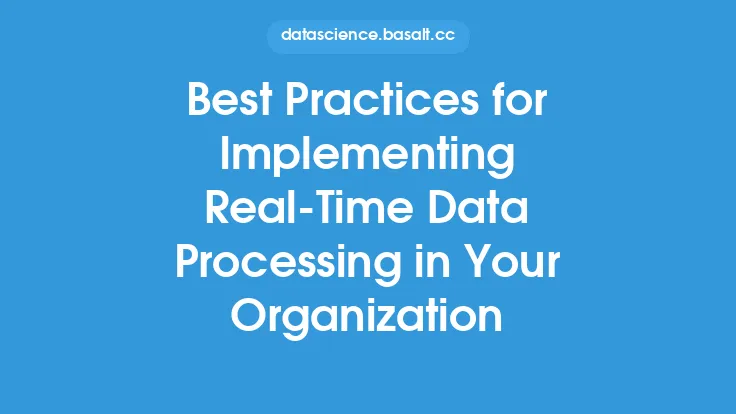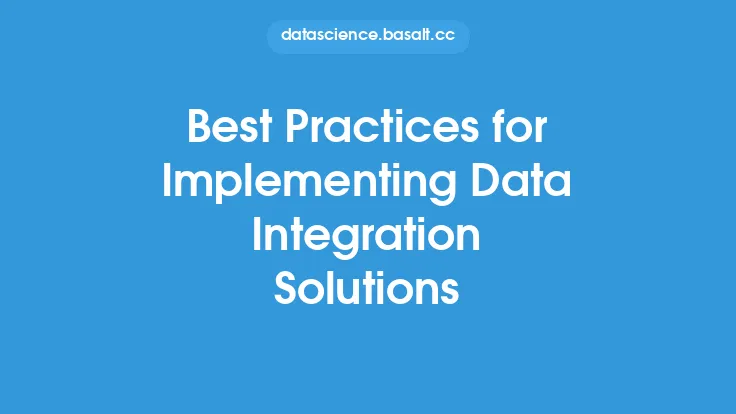Implementing data privacy by design is a crucial aspect of data governance, as it ensures that personal data is protected from the outset, rather than as an afterthought. This approach involves designing systems, processes, and products with data privacy in mind, taking into account the potential risks and consequences of data collection, storage, and use. By incorporating data privacy by design principles, organizations can minimize the risk of data breaches, ensure compliance with regulatory requirements, and build trust with their customers.
Introduction to Data Privacy by Design Principles
Data privacy by design principles are based on the concept of "privacy by design," which was first introduced by Dr. Ann Cavoukian, the former Information and Privacy Commissioner of Ontario, Canada. The core idea is to design systems and processes that protect personal data from the outset, rather than relying on add-on measures or retrofits. This approach involves considering data privacy implications at every stage of the design process, from conceptualization to implementation. The key principles of data privacy by design include:
- Proactive, not reactive: Anticipate and prevent data privacy issues, rather than reacting to them after they occur.
- Privacy as the default: Ensure that personal data is protected by default, without requiring users to take additional steps.
- Privacy embedded into design: Integrate data privacy considerations into the design process, rather than treating them as an afterthought.
- Full functionality: Ensure that data privacy measures do not compromise the functionality of the system or process.
- End-to-end security: Implement robust security measures to protect personal data throughout its entire lifecycle.
- Visibility and transparency: Provide clear and transparent information about data collection, use, and sharing practices.
- Respect for user privacy: Prioritize user privacy and provide them with control over their personal data.
Implementing Data Privacy by Design in Practice
Implementing data privacy by design requires a multidisciplinary approach, involving input from stakeholders across the organization, including product development, engineering, marketing, and compliance teams. The following steps can help organizations implement data privacy by design in practice:
- Conduct a privacy impact assessment: Identify potential data privacy risks and consequences associated with the system, process, or product.
- Develop a data privacy strategy: Establish clear goals, objectives, and guidelines for data privacy, aligned with organizational values and regulatory requirements.
- Design for data minimization: Collect and process only the minimum amount of personal data necessary to achieve the intended purpose.
- Implement data protection by default: Ensure that personal data is protected by default, using techniques such as encryption, access controls, and secure storage.
- Use privacy-enhancing technologies: Leverage technologies such as differential privacy, homomorphic encryption, and secure multi-party computation to protect personal data.
- Provide transparent and user-friendly privacy notices: Inform users about data collection, use, and sharing practices, using clear and concise language.
- Establish a data governance framework: Define roles, responsibilities, and processes for managing personal data, ensuring accountability and oversight.
Technical Considerations for Data Privacy by Design
From a technical perspective, implementing data privacy by design requires careful consideration of various factors, including:
- Data encryption: Use robust encryption algorithms and protocols to protect personal data both in transit and at rest.
- Access controls: Implement role-based access controls, ensuring that only authorized personnel can access personal data.
- Data anonymization: Use techniques such as data masking, tokenization, or pseudonymization to protect personal data.
- Data storage: Use secure storage solutions, such as encrypted databases or secure file systems, to protect personal data.
- Data transfer: Use secure protocols, such as HTTPS or SFTP, to protect personal data during transfer.
- Data deletion: Implement secure data deletion practices, ensuring that personal data is permanently erased when no longer needed.
Benefits of Implementing Data Privacy by Design
Implementing data privacy by design offers numerous benefits, including:
- Regulatory compliance: Ensure compliance with data protection regulations, such as the General Data Protection Regulation (GDPR) or the California Consumer Privacy Act (CCPA).
- Risk reduction: Minimize the risk of data breaches and associated consequences, such as reputational damage and financial losses.
- Trust and reputation: Build trust with customers and stakeholders, demonstrating a commitment to data privacy and protection.
- Competitive advantage: Differentiate your organization from competitors, showcasing a proactive approach to data privacy and protection.
- Cost savings: Avoid costly retrofits or add-on measures, integrating data privacy considerations into the design process from the outset.
Challenges and Limitations of Implementing Data Privacy by Design
While implementing data privacy by design offers numerous benefits, there are also challenges and limitations to consider, including:
- Complexity: Integrating data privacy considerations into the design process can add complexity, requiring significant resources and expertise.
- Cost: Implementing data privacy by design may require significant investment in new technologies, processes, and personnel.
- Legacy systems: Integrating data privacy by design principles into existing systems and processes can be challenging, requiring significant retrofits or upgrades.
- Balancing privacy and functionality: Ensuring that data privacy measures do not compromise the functionality of the system or process can be a delicate balance.
- Evolving regulatory landscape: Keeping pace with evolving regulatory requirements and standards can be challenging, requiring ongoing monitoring and adaptation.
Conclusion
Implementing data privacy by design is a critical aspect of data governance, ensuring that personal data is protected from the outset. By incorporating data privacy by design principles, organizations can minimize the risk of data breaches, ensure compliance with regulatory requirements, and build trust with their customers. While there are challenges and limitations to consider, the benefits of implementing data privacy by design far outweigh the costs, providing a competitive advantage, reducing risk, and promoting a culture of data privacy and protection.





